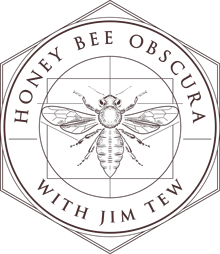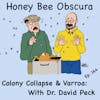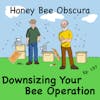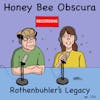Dealing With Heavy Hives with Anne Frey (167)

In this episode, Jim Tew and Anne Frey tackle a common yet often overlooked challenge in beekeeping: managing the heavy weight of hives. They delve into practical solutions and innovative ideas to make beekeeping tasks more manageable, emphasizing...
In this episode, Jim Tew and Anne Frey tackle a common yet often overlooked challenge in beekeeping: managing the heavy weight of hives. They delve into practical solutions and innovative ideas to make beekeeping tasks more manageable, emphasizing that this issue impacts beekeepers regardless of age, gender, or experience level.
They both stress the importance of adapting beekeeping practices to accommodate individual capabilities and limitations, suggesting that small adjustments can lead to a more enjoyable and sustainable beekeeping experience. Whether through the strategic use of equipment or altering traditional methods of hive management, the episode offers a wealth of knowledge for beekeepers looking to lighten their load.
This conversation not only sheds light on the physical demands of beekeeping but also champions a more inclusive and thoughtful approach to the craft, ensuring it remains accessible and fulfilling for everyone. Join Jim and Anne as they explore ways to overcome one of beekeeping's most weighty challenges.
Listen today!
______________________
Thanks to Betterbee for sponsoring today's episode. Betterbee’s mission is to support every beekeeper with excellent customer service, continued education and quality equipment. From their colorful and informative catalog to their support of beekeeper educational activities, including this podcast series, Betterbee truly is Beekeepers Serving Beekeepers. See for yourself at www.betterbee.com
______________________
Honey Bee Obscura is brought to you by Growing Planet Media, LLC, the home of Beekeeping Today Podcast.
Music: Heart & Soul by Gyom, All We Know by Midway Music; Christmas Avenue by Immersive Music; original guitar music by Jeffrey Ott
Cartoons by: John Martin (Beezwax Comics)
Copyright © 2024 by Growing Planet Media, LLC

Episode 167 – Dealing With Heavy Hives with Anne Frey
[music]
Jim Tew: Well, hello again, listeners. The thing that's weighing on me today is why is all things in beekeeping so heavy? It just seems like as I've aged more and more, and I talk about aging too much, but nonetheless, things just seem heavy. I'm here with Anne Frey, and she's done some interesting concepts and put some thought into how to make the weight of typical beekeeping task more, what, intolerable?
Anne Frey: Magical, tolerable, handleable.
Jim: Yes. I'm waiting to hear if you're going to use the word enjoyable. You didn't use the word enjoyable.
Anne: No, I didn't.
Jim: [laughs]
Anne: Huh?
Jim: All right. How to make heavy beekeeping more manageable. Standby, we will talk some about it. I'm Jim Tew, and I'm coming to you about once a week at Honey Bee Obscura where we try to talk about something to do with beekeeping.
Anne: I'm Anne Frey from Betterbee trying to help out.
Jim: Standby, we will talk about how to lighten your bee load as much as we can.
Introduction: Welcome to Honey Bee Obscura, brought to you by Growing Planet Media, the producers of the Beekeeping today podcast. Join Jim Tew, your guide through the complexities, the beauty, the fun, and the challenges of managing honeybees. Jim hosts fun and interesting guests who take a deep dive into the intricate world of honeybees. Whether you're a seasoned beekeeper or just getting started, get ready for some plane talk that'll delve into all things honeybees.
Jim: That it's common sense if you keep bees. I don't remember the realization the first time I had of how heavy a box of honey really was, who designed those little handholds that you can only use the last tip of your fingers to pick up 40 or 50 or 60 pounds of honey. After I've worked all day in the old days, the last tips of my fingers would be so sore is to be almost disagreeable about this. Honey is heavy, beekeeping equipment is heavy. Five gallon cans of honey are heavy. Drums of honey are heavy. Honey is heavy. What's been your experience with some of this?
Anne: Well, I do think that whoever invented those little handholds had more to do with producing lumber than beekeeping. Yes, those handholds are ridiculous. I definitely believe that anybody who's not a migratory beekeeper could do better for themselves by adding strong handles on the sides, it feels like it takes away 30% of the weight of a heavy box when you can get a real good grip. Things like that is the kind of thing that I advise hobbyists to do just to make their lives more enjoyable, manageable. [laughs]
Jim: We know right off the bat that someone is going to argue with us, but I'm 100% with you. Ohio State people used to put those strips on the ends of the boxes. You had a strip, a three-quarter inch strip. You could get a better grip. It still wasn't like a choke hold grip, but you could get a better grip, but then what that strip did was keep you from stacking the colonies tightly onto a truck. If space was critical to you--
Anne: Yes, they don't get together. If somebody was clever, they would somehow alternate the back and front strips with the ones that had them on the side, so it all nested together. But no, that's ridiculous. Yes, it's not for people that are big-time beekeepers. My tips and ideas are mainly for the hobbyist who they're just frustrated with the simple weight of dealing with 1 to 12 hives or something like that.
Jim: I need to be very, very careful here. This is not a man versus woman. This is not a strong versus weak.
Anne: Old versus young.
Jim: Weight is relative to the person. It's not like I'm strong and you're not.
Anne: Yes. Short versus tall.
Jim: More often than not, what can I do even at my age now to lighten loads so I don't snap a bike and spend weeks and weeks getting over it? What if I'm not mobile? What if I'm a person who's not really mobile? There's all kinds of reasons that I want to worry and be concerned about the weight of beekeeping, so I won't be eliminated from beekeeping. There's nothing wrong with talking about it. It's not a tough guy versus a weak guy situation.
Anne: It might also be there's this super enthusiastic fifth grade kid, girl or boy that wants to be in beekeeping. There are ways for people of all types to do beekeeping, and I think it has to do with basically not seeing the box as the unit. Or the 50, what would you say, the box as a unit or the 5 gallon pale as the unit. I would just change your brain and start thinking of the pieces as units, the frames inside of the box or the honey inside of the bucket. Nobody says you have to fill up a five gallon pail all the way when you have to move honey. Nobody says you have to use a five gallon pail.
Jim: You know, you don't.
Anne: No.
Jim: It's a mindset, I think.
Anne: Totally.
Jim: I've got a 10-frame box and it's a deep, it's going to be heavy as all get out. It's going to weigh just under 100 pounds, that's going to be about all that I can manage, especially if the hive is on a hive stand 18 to 20 inches off the ground, and it's on maybe 3 deeps, 2 deep, 3 deeps, 3 supers, that's going to be-- I'm actually hugging this thing about neck heights. Everything about this, just this pleads for a bad back. It's that old joke. First time I heard it, John Root from the A.I. Root Company gave it in a talk. He said-
Anne: Oh, I know this one.
Jim: -that go ahead. You say it, then you tell me this.
Anne: There's two kinds of beekeepers, those who have a bad back and those who will have a bad back.
Jim: Everything about beekeeping is designed that box, you said it starting was a lumber thing. That box was not built because that was the perfect design for bees. It was an efficient cut of lumber for that box size, and the scraps that was left to be used for other things, the bees were never asked. It's a really odd box from a woodworking standpoint. It offends the golden mean of design, but nonetheless, it is what it is. It's here, and it's the Langstroth hive, but it's awkward to pick up. It's heavy to pick up. I like your idea of taking out frames, but you can only do that if you've got a reasonable number of hives. If you're managing hundreds or even commercial, you got to go bigger. Your equipment's different, everything about it is different.
Anne: Yes. We're not talking about that scale. What I would like to try to get newer people or people that aren't the big and burly beekeepers to get into their heads that if that super up high is too heavy or too heavy just because it's high, they could reach up there and take out each frame. For instance, take out if there's 10 frames or 9 frames in the honey super, take out 4 of them and put it in another safe box on the ground.
Then you have a box that's half as heavy and another box that's half as heavy and you can carry them to the truck. Then the hive is shorter and you could do it again if you want, or take the next box off in its entirety. It's, you don't always have to do what you started out doing, picking up these empty boxes. They're beautiful and light when you first buy them. They're only going to get heavier, and the highest-
Jim: They're going to get heavier.
Anne: -ones are the heaviest ones.
Jim: Yes, that is. And the clumsiest.
Anne: Right.
Jim: The bees are always so excited. They're so agreeable to having you there cracking and breaking it loose, and you're right there, they're right there at your neck level. Everything about this, we sound like we're complaining. I'm not complaining. No, it's a good honey crop. The bees made a lot of honey. It's time to get it off and it just turns into work, and it does take time. What you're talking about does take time. While you were saying, take the frames out, the bees are unhappy about this, but the thing is, you can get the job done. You can get the task done and even though it takes you more time, it's a lot less time that you'd spend healing a bad back with a kink or a snap that you had done.
Anne: Oh, true, true. Totally. I'd like to point out a good way to get a bad back or a twisted knee is to use a ladder for those high things and give my idea for getting up high. Don't even think about a step ladder and those tiny little steps turning yourself around on the ladder to climb down with the heavy supra super. Also, I'm kind of taking for granted that people have a lot of extra equipment sitting around. With your extra equipment, I would say put a deep on the ground and put a telescoping outer cover on it and step on that. If you have to get up higher, put two in front of it on top of each other, so that's your second step. They're big, they're wide, they're stable.
Jim: Yes, I can go with that.
Anne: Go with that. It's just trying to think differently. If you're prying things apart and it seems like it's too heavy and it's too hard, the right thing to do is think, not just try harder and harder and harder. Pause and think.
Jim: This is a good time to pause and think right here, hear from our sponsor, and then come back. I want to charge dead head long into the old appliances that are not available that would help you pick hives up.
Anne: Sure.
Betterbee: Now that your bees are cozy for the winter, let's turn up the heat with better bees mind blowing classes. Led by the brilliant Dr. David Peck and the fantastic EAS master beekeeper Anne Frey, these classes cover everything from beekeeping basics to advanced winter wisdom. Whether you're a winter beekeeping beginner or seasoned pro in the apiary. Our classes cover everything from snowy basics to advanced insights for winter beekeeping. Head over to betterbee.com/classes and unlock the secrets to upping your beekeeping game because it better bee, we're all about keeping you warm with knowledge all winter long.
Jim: When you were talking about that ladder business and you said, "Don't get on the ladder," you weren't talking to me, right?
Anne: Oh, I don't know. It might've been.
Jim: I don't want to confess that I've ever been on a ladder by a beehive or chasing a swarm but ladders and bees rarely ever mix but when that swarm is hanging and you can put a-frame ladder in the back of a truck and just barely reach it, you do it. Now I'm off the subject. Ladders and bees rarely ever mix but they're often ideas that, "Well, just this one time. Just this one time." If you look through all the hurdles of devices that have come and gone, all this weight problem has been a thing since bees were kept in boxes.
There's these tripod things and little block and tackle contraptions but every one of those deals, every one of those things acted as though that I had a 2 acre yard, acre, for four or five beehives that you got all this room around these beehives. There's no communal stands. Every hive is on a single stand so you can put this gadget over it. I tried to figure out a way to take my little Kubota tractor with a bucket loader on it to see if I could figure out some way to pick up a deep off a beehive with a loader. You got to get a tractor up there. The bucket's over it, it's just comical. You got to have a yard, an acre size with beehives 25, 30 feet apart if you're going to tinker with these kind of ideas.
Anne: I do like the idea of using the tractor though.
Jim: I thought, "I'll use the bucket and if I'll just get the bucket level and then I'll break the box off, slip it in the bucket, and then lower it to the ground." Well, this is not exactly hobby beekeeping. This is just because I happen to have the tractor for a more with a bucket on it that I could use it for that but that'll give you some idea of the extremes you go to just to deal with the weight of these things.
Anne: Beekeepers with weight problems is what we're talking about.
Jim: Beekeepers with weight problems, yes.
Anne: Another way to deal with it besides that tractor is some sort of hive lifter and there's a few different kinds out there or you could make one yourself. It doesn't take a lot of equipment, just a little skill but there's mechanical ones. I saw someone had a tailgate that dropped down like an elevator that he had mounted on his pickup truck long ago.
Jim: I had one of those. Those tailgates were called Tommy lift gates.
Anne: Tommy lift.
Jim: They're still available. You see these trucks all over town, the front, Tommy lift. I had one of those on my truck. I had a store crane. They have not been available for years. They were really highly engineered. They were not cheap. You replaced the back bumper on your truck and a collapsible crane folded into that bumper so when you wanted to move a beehive, you set the crane up. There was an electric winch on it. It would swing around, pivot. It had a hive clamp that came over the colony and pick it up by the handholds and picked it up and spun it back around and dropped it off on the truck.
Anne: Wow.
Jim: That was the epitome of overkill.
Anne: Changing from a hobbyist to a sideliner. That kind of thing probably was pretty expensive.
Jim: It was expensive. Even then it was hundreds and hundreds of dollars just to get put on my truck. In fact, it was a quick conversation. The guy said, "How much is it worth to you to have this thing put on this truck?" I said, "Oh, I don't know. About $400, I guess. I didn't know. When I picked it up, you know how much it cost to have that put on? $400."
Anne: Exactly.
Jim: The guy said he was never going to do that job again. He didn't know what he was getting involved in. Once you had it on, you had this crane contraption there but it really limited you and everything was in a semicircle around the truck or you had to move the truck. Then when you got them into the truck, it was hard to move them and get them stacked on each other so you still had the same problem.
Anne: It probably just swung around to a particular ideal spot on the bed. Didn't know nowhere else.
Jim: No.
Anne: I'm thinking that if a person's thinking of going that far they might be better off cultivating a few teenagers or going to a different idea altogether which would be, I mentioned the hive lifter and yours could be used as a hive lifter too but it's good as a super lifter where the two person device that will pick up a hive, you can just pick up supers off of the top of the hive with two people per super and it clearly is going to be half the weight. That's one idea.
These gadgets that engineering people that have never done beekeeping create, reminds me of a conference I was at where they had a gadget competition and someone created a kind of bipod thingy that was supposed to jam under your kitchen counter by the kickplate and help you to pick up a full 5 gallon bucket from the floor up to the counter. You would swing it up there. This tall bipod. I was thinking to myself, "That's clever but I'd rather use a two-gallon bucket and not even pick up that five-gallon bucket to the counter." I didn't say it to the inventor but that's the way my brain works.
Jim: I can appreciate that. You make more trips but each trip is more manageable.
Anne: Like the bees do.
Jim: If something goes horribly wrong, cleaning up two gallons is far easier than cleaning up five gallons.
Anne: Yes, it takes longer but spreading the workout into smaller tasks, smaller amounts like the bees do.
Jim: I guess the bottom line is ultimately it's just going to be heavy. Honey weighs what it weighs.
Anne: True. 12 pounds per gallon.
Jim: We just work around it. It is what it is. It's a heavy product by nature. As we wind down in this segment, there is a question I'd like to bring up. What do you do with those hives that have been left to their own? They haven't been open in a year or two and they've really gummed everything up. There's burr comb. They're packed out. They are locked in solid.
Anne: Who lets the bees get like that?
Jim: Pulling out a frame or two there is going to be a lot of work.
Anne: Yes. You pry too hard, you're going to have top burrs popping right off.
Jim: When I have those plastic frames they just flex and the and the hive two just snaps by them. They don't come up. Where I'm going with this at that point, what I've done in the past is to get back to your plan. I set the deep up on end and then from the bottom I use a short handle hammer and I meaningfully tap where the end burrs join the bottom burrs on each end. Tap, tap, tap, go to the other end burr, tap, tap, tap. Now, all the time the bees are taking a real dim view of this-
Anne: Usually smoke.
Jim: -so you better have your smoker going. Tap, tap, tap, tap, tap, tap, until I break that frame loose and can get one frame out and then take the other frame out. Then once I've got two frames out, then you can snap, snap, the way you talked about remove frames at the time.
Anne: I wouldn't use that kind of meaningful, what was it? Masterful, thoughtful hammer application in every case but I like it because you've thought of a different way of solving the problem and sometimes the hives, these older ones that have been neglected are just too stuck together. You might tear the top bars off of all 10 of those frames before you thought of a different technique. I like it.
Jim: That's just a doomsday thing for a colony that has been left to its own merit. When it's really clogged up, when you and I are talking, we're thinking of frames that slide right out and colonies that have been worked routinely. What if you get one of those that's all gummed up and this I've got wrecking bars, crowbars, heavy tools, everything? You're exactly right. You just tear the top bars up. They pull off.
Anne: Another idea I'd like to throw in there, if you have a hive that you had to adopt or, because it wouldn't be your hive that got neglected, right? It came from some other place.
Jim: No, I wouldn't be mine. No, no. Never have.
Anne: You wanted to probably investigate those frames, but the idea of getting them apart is horrible. I would maybe suggest put a box on with frames, a foundation or comb above it and just let the bees get themselves out of those two boxes by waiting for three weeks and they would all rise up into your boxes by themselves with no hammer.
Jim: I'd say. You'd let the bees solve the problem for you.
Anne: It could work depending on their mood and how much honey they had down there. The other thing is you might have wanted to investigate it before that because you wanted to check and see if they had American foulbrood first. These are iffy ideas. You have to check that brood.
Jim: I hope we didn't leave the impression listeners that somehow we can make beekeeping lighter for you, we're not going to do that. We can't do it. All you can do is do the best you can to lighten your individual loads. Be careful and we ended on that note, check your brood for American foulbrood when you get it out just to sure because you're scattering, moving, whatever, but that's a talk for another time.
Anne: Yes, that was a tangent.
Jim: [laughs] Right. Hey, and I always enjoy talking with you.
Anne: Thanks, Jim.
Jim: Can we do this again sometime?
Anne: Yes. It's always fun.
[music]
[00:22:19] [END OF AUDIO]
New to Honey Bee Obscura Podcast?
Here are some great episodes to start with. Or, check out episodes by topic.







 In this episode, Jim Tew and Anne Frey tackle a common yet often overlooked challenge in beekeeping: managing the heavy weight of hives. They delve into practical solutions and innovative ideas to make beekeeping tasks more manageable, emphasizing that this issue impacts beekeepers regardless of age, gender, or experience level.
In this episode, Jim Tew and Anne Frey tackle a common yet often overlooked challenge in beekeeping: managing the heavy weight of hives. They delve into practical solutions and innovative ideas to make beekeeping tasks more manageable, emphasizing that this issue impacts beekeepers regardless of age, gender, or experience level.






